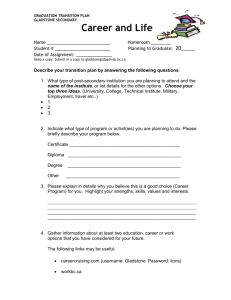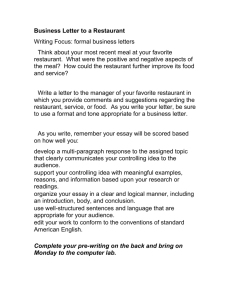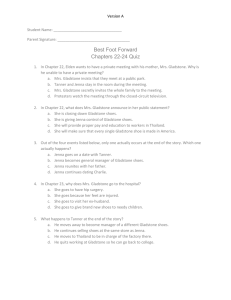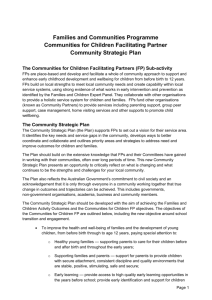News Flash Dealing with Intense Media Scrutiny During a Business
advertisement
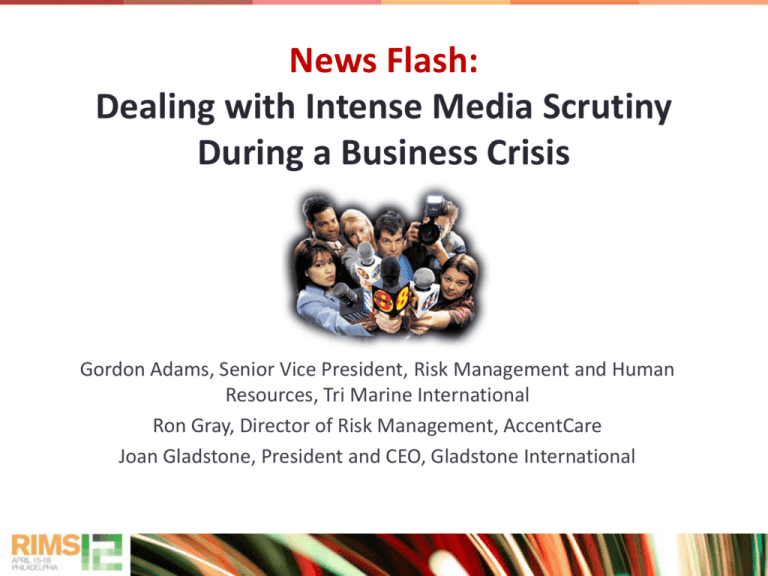
News Flash: Dealing with Intense Media Scrutiny During a Business Crisis Gordon Adams, Senior Vice President, Risk Management and Human Resources, Tri Marine International Ron Gray, Director of Risk Management, AccentCare Joan Gladstone, President and CEO, Gladstone International Case Analysis Ron Gray Director of Risk Management AccentCare Crisis communications plan – One year before the incident • • • • Formed a crisis communications team Set internal media policy Conducted media training for spokespersons Identified key audiences – Who to contact in the first critical hours • Evaluated communications vulnerabilities – Recommendations to enhance existing procedures On Easter Sunday, a customer told one of our restaurant managers that he found a “foreign object” in his French onion soup Immediate Response • Apologize for customer’s experience • Request object for testing • Retain independent investigator to interview employees • Discard all but small batch of soup April 12 – May 31 Customer • Does not respond to numerous requests to test object • Hires an attorney, threatens media • Holds object for six weeks, then sends it to lab • Asks that all female employees be tested for DNA June 1 – July 20 • Object finally sent to second lab • All female employees agree to DNA test – No match to DNA on object • The customer and family agree to DNA test • The customer fails to appear for test • The following day… Plaintiff’s attorney emails complaint to all Southern California media “(Customer) has had many sleepless nights…he may have contracted any number of life threatening diseases or illnesses…” “His wife claims damages for LOSS OF CONSORTIUM…” July 21 • Implement crisis communications plan – Media statement to Orange County Register • Post on corporate website – Media log – Media policy reminder • Provide statement to restaurant managers – Reminder to refer all media inquiries to corporate Stand-by Media Statement - Partial Text We have found no evidence to support any of the allegations in a 'foreign object in the food' allegation filed by (customer) against (company) on (date) ….describe company actions to date… After a thorough investigation, there was no evidence of any employee involvement or wrongdoing. We believe the lawsuit has no merit and that we will be vindicated in court. July 21 - 22 • Story published in the Orange County Register – Sets off social media frenzy – Conan O’Brien • Two L.A. TV stations seek interviews with company spokesperson – Provide written statement instead of interviews • Avoid lending credibility to the customer’s claim KTLA-TV • Posts company statement, Register story, complaint on website – Airs customer interview, restaurant statement “Dirty Dish – truth or a way to make money?” KABC-TV • Cancels segment after reading corporate statement “The statement validated why we should not run the story” - KABC producer July 24 • OC Register does second, longer feature story on family – Adds research that the customers owe $300K in back taxes to the IRS – Requested that we provide an updated statement based upon the newer story Outcome • Blog and reader attention diminishes to zero mentions one week later • Little impact on restaurant sales One Year Later • The customers seek their day in court • National media coverage, again – Reader support for the restaurant higher than before • Case settles Takeaways • Having a pre-prepared statement alleviated undue stress and arguments • Having a media policy stopped employees from discussing the incident. • Media events are stressful, being prepared for one is job security Managing Media Scrutiny in a Crisis Joan Gladstone Gladstone International, Inc. www.gladstonepr.com The Good News Business crises usually provide warning signs, giving you time to plan With good planning, you may avert or mitigate media coverage of the crisis Three elements of crisis communications planning* The Media The Message The Messenger *you’ll practice in this session You vs. the Media in a Crisis The Media • Since you can influence, but not control – Traditional journalists: print and broadcast – Citizen journalists: bloggers, social media posts • Add YOUR media to the mix YOUR Media • • • • • Website Social media Email Phone calls Internal media Product Recall Case • Website • “Dark” crisis page • Consumer/dealer letter • CPSC news release review • Social media – YouTube “how to” video Tell it once, tell it fast The Message Messages = Persuasive “Quotes” Emphasize 1.Factual information 2.Authoritative opinions 3.Concise explanations 4.Empathy statements (as needed) Anticipate Media Questions in a Crisis • • • • • • WHAT happened? WHEN did you find out? WHO was responsible? WHERE did it happen? WHY did you choose this course of action? HOW will you resolve the situation? The Messenger Choose the Right Spokesperson(s) Former BP CEO Tony Hayward “I’d like my life back” In a crisis, good spokespeople - Provide reassurance - Offer critical facts/clear instructions - Exhibit confidence Tip: Offer media training before a crisis hits Crisis PR professionals can help you balance many priorities and meet difficult communications challenges Next: Press Conference Role-Play Objectives • Learn how to prepare for challenging media encounters • Experience the power of teamwork in managing a realistic press conference • Learn how to quickly develop media questions, messages, statements and brief spokespeople • Assess crisis communications strategies to apply to your organization Process • • • • Team assignments Team deliberation Hold press conference Debrief

